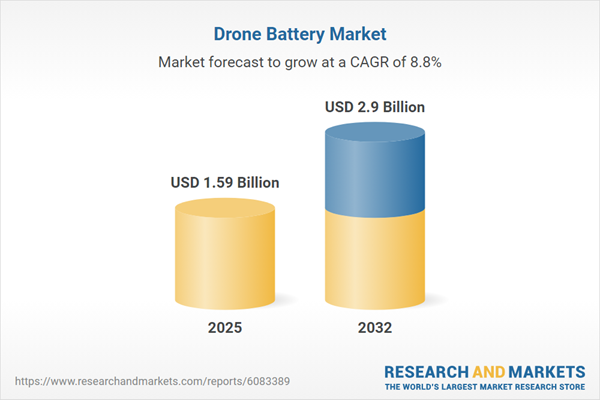Speak directly to the analyst to clarify any post sales queries you may have.
The drone battery market is entering a critical phase of evolution as energy storage technologies become increasingly central to the future of unmanned aerial applications. Senior leaders are facing new pressures and opportunities stemming from supply chain shifts, regulatory complexity, and relentless changes in adoption patterns and technology options.
Market Snapshot—Drone Battery Market
The Drone Battery Market grew from USD 1.47 billion in 2024 to USD 1.59 billion in 2025. It is expected to continue growing at a CAGR of 8.81%, reaching USD 2.90 billion by 2032. The trajectory is driven by demand from commercial, industrial, and defense sectors, as drones take on more complex missions requiring reliable, long-lasting power solutions. Market participants must navigate heightened expectations for battery performance, safety, and cost optimization in the face of volatile regulatory and technical environments.
Scope & Segmentation
- Battery Chemistry: Lithium Polymer (LiPo), Lithium-ion Polymer (Li-ion), Nickel Cadmium (Ni-Cd)
- Technology Type: Wired Charging, Wireless Charging
- Capacity: 1000-5000 mAh, Less Than 1000 mAh, More Than 5000 mAh
- End User: Commercial (Agriculture, Media & Entertainment), Consumer (Photography, Racing, Recreational), Industrial (Inspection, Mapping, Surveying), Military (Combat, Reconnaissance, Surveillance)
- Distribution Channel: Aftermarket, Original Equipment Manufacturer
- Regions: Americas (United States, Canada, Mexico, Brazil, Argentina, Chile, Colombia, Peru), Europe, Middle East, & Africa (United Kingdom, Germany, France, Russia, Italy, Spain, Netherlands, Sweden, Poland, Switzerland, United Arab Emirates, Saudi Arabia, Qatar, Turkey, Israel, South Africa, Nigeria, Egypt, Kenya), Asia-Pacific (China, India, Japan, Australia, South Korea, Indonesia, Thailand, Malaysia, Singapore, Taiwan)
- Leading Companies: AMIT industries LTD., Amprius Technologies, Inc., AUTEL ROBOTICS Co., Ltd., Doosan Mobility Innovation Co. Ltd., EaglePicher Technologies, Enix Power Solutions, Epsilor-Electric Fuel Ltd., Gelion PLC, HES Energy Systems Pte. Ltd, Homeland Surveillance & Electronics LLC, Honeywell International Inc., Hylium Industries, Inc., Intelligent Energy Limited by Meditor Group, Inventus Power, Jackvolt, KULR Technology Group Inc., LG Chem Ltd., Magnipower Lithium Private Limited, MaxAmps, Montavista Energy Technologies Corporation, Plug Power Inc., RRC power solutions GmbH, SES AI Corporation, Shenzhen Grepow Battery Co., Ltd., SZ DJI Technology Co., Ltd., Texas Instruments Incorporated
Key Takeaways for Strategic Decision-Makers
- Battery technology innovation—driven by advancements in chemistry, form factor, and digital integration—is directly improving drone mission range, reliability, and cost of ownership.
- Collaboration across disciplines—material science, electronics, and software—has paved the way for solutions like rapid charging, predictive maintenance, and advanced safety protocols.
- The adoption of AI-based battery management is enabling real-time health insights and extended service intervals, optimizing operational uptime and lifecycle costs.
- Integration with IoT platforms empowers operators with actionable data, enhancing maintenance efficiency and driving further energy optimization over time.
- Cross-sector partnerships, especially with automotive and renewable energy industries, are helping scale production efficiencies and facilitate technology transfer.
- Emerging standards and regulatory updates are influencing technology development, safety certifications, and international market entry strategies.
Tariff Impact: Navigating Supply Chain and Cost Pressures
The introduction of new United States tariff measures in 2025 has forced the drone battery sector to reassess procurement strategies. Cost pressures on key components are prompting companies to build resilient supplier networks, invest in local sourcing, and accelerate value engineering. Regional incentives and collaborative industry-government programs are encouraging domestic manufacturing and workforce development to bolster supply chain stability. Proactive adaptation to these trade policy shifts has become a differentiator in the competitive landscape.
Methodology & Data Sources
This report leverages a research framework combining primary interviews with senior executives, technical and supply chain experts, alongside secondary research from public filings and technical papers. Analytical rigor is maintained through data triangulation, scenario modeling, and exhaustive expert validation to ensure transparency and credibility in findings.
Why This Report Matters
- Provides clarity on evolving global and regional drone battery trends for confident strategic planning.
- Enables leadership teams to benchmark technology adoption and supplier strategies against leading industry players.
- Equips organizations to anticipate risks, navigate regulatory shifts, and leverage innovation for market advantage.
Conclusion
The drone battery market is defined by material advancements, digital innovation, and adaptive supply strategies. Organizations aligning with these changes can unlock new value and sustain growth across an evolving landscape.
Table of Contents
3. Executive Summary
4. Market Overview
7. Cumulative Impact of Artificial Intelligence 2025
Companies Mentioned
The companies profiled in this Drone Battery market report include:- AMIT industries LTD.
- Amprius Technologies, Inc.
- AUTEL ROBOTICS Co., Ltd.
- Doosan Mobility Innovation Co. Ltd.
- EaglePicher Technologies
- Enix Power Solutions
- Epsilor-Electric Fuel Ltd.
- Gelion PLC
- HES Energy Systems Pte. Ltd
- Homeland Surveillance & Electronics LLC
- Honeywell International Inc.
- Hylium Industries, Inc.
- Intelligent Energy Limited by Meditor Group
- Inventus Power
- Jackvolt
- KULR Technology Group Inc.
- LG Chem Ltd.
- Magnipower Lithium Private Limited
- MaxAmps
- Montavista Energy Technologies Corporation
- Plug Power Inc.
- RRC power solutions GmbH
- SES AI Corporation
- Shenzhen Grepow Battery Co., Ltd.
- SZ DJI Technology Co., Ltd.
- Texas Instruments Incorporated
Table Information
| Report Attribute | Details |
|---|---|
| No. of Pages | 197 |
| Published | November 2025 |
| Forecast Period | 2025 - 2032 |
| Estimated Market Value ( USD | $ 1.59 Billion |
| Forecasted Market Value ( USD | $ 2.9 Billion |
| Compound Annual Growth Rate | 8.8% |
| Regions Covered | Global |
| No. of Companies Mentioned | 27 |









